 1978-1983
1978-1983
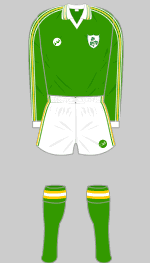
1978-1983
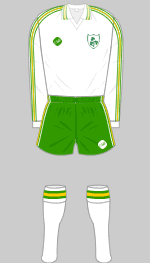
1978-1983 Change
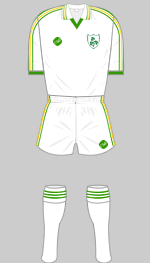
20 Oct 1978
v N Ireland
Designer: O'Neill's
O'Neill's updated their previous design by adding gold trim to create a strikingly effective strip. Variants to the home shirt included green V necks and green cuffs. The away kit was a simple reversal of the "home" outfit.
For the first time ever, the two Irish teams met in the 1980 European Championship qualifiers. The Republic wore an all-white strip for the first match, which was held in Dublin and ended 0-0.

 1983-1985
1983-1985
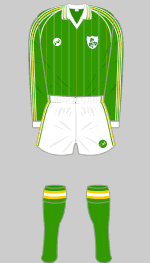
1983-1984
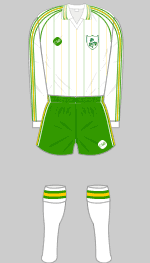
1983 Change
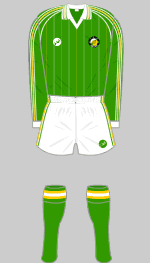
March-April 1983
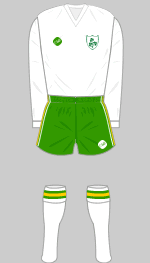
Nov 17 1984 v Norway
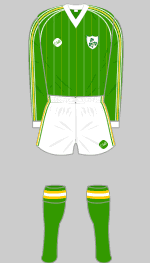
Feb-March 1985
Designer: O'Neill's
O'Neill's updated the Irish kits once again in 1983, adding fashionable alternating pinstripes in white and gold and a white seam running from the collar to armpit. Variations included a redesigned crest, worn when the Irish team visited Malta and Spain, and plain white V necks worn in the first few months of 1985, including the match against England on 26 March, shortly before the strip was retired.

 1985
1985
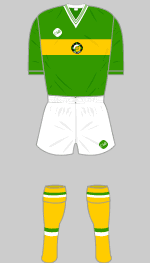
May 1 1985
v Norway
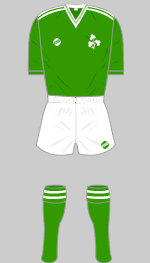
From 26 May 1985
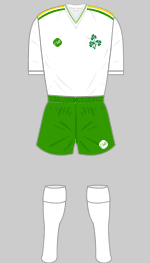
Sept 11 1985
v Switzerland
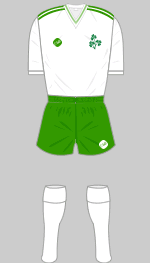
October 16 1985
v Russia
Designer: O'Neill's
After a series of disappointing results, the FAI asked O'Neill's to create a new strip in the hope of inspiring some improvement. The result was something of an oddity, featuring a gold chest band and predominantly gold stockings. The circular crest, first seen in 1983 made a reappearance. Worn once, in a poor performance against Norway in a World Cup qualifier that finished 0-0, the kit was never seen again. For the rest of the year Ireland played in more traditional plain green shirts with three white stripes across the shoulder. The complementary change kit featured green and gold stripes but was otherwise a reversed version of the home kit. A variant was worn when the Irish played the Soviet Union in the penultimate qualifier for the 1986 World Cup. A 0-2 defeat confirmed that, yet again, Ireland would not be playing in the final stages.
The three shamrocks crest was restored but now sewn directly onto the shirt without a background shield.

 1986-1987
1986-1987
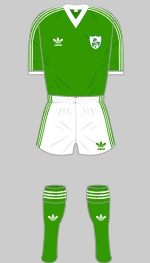
1986
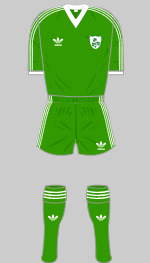
1986 v Belgium
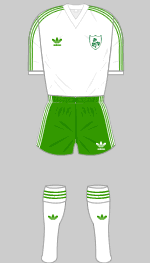
1986 Change
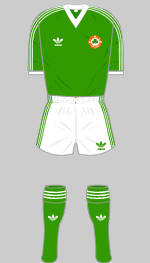
1987
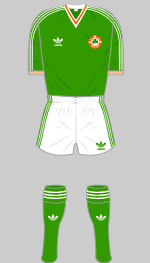
Nov 10 1987
v Israel
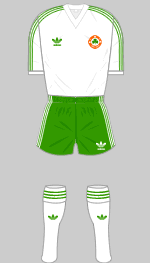
1987 Change
Designer: Adidas
 In 1986 Jack Charlton was appointed as manager to the Irish team and set about a wholesale transformation. Underlining his intention to reinvigorate the team, the long-standing relationship with O'Neill's was severed and Adidas became the FAI's kit supplier. The simple green and white strip (with elements that were interchangeable with the change kit) was the standard Adidas template of the period and is now regarded as a design classic. At the time, it gave the Irish team a contemporary, European look, given the almost complete domination of the international market by the German sportswear company.
In 1986 Jack Charlton was appointed as manager to the Irish team and set about a wholesale transformation. Underlining his intention to reinvigorate the team, the long-standing relationship with O'Neill's was severed and Adidas became the FAI's kit supplier. The simple green and white strip (with elements that were interchangeable with the change kit) was the standard Adidas template of the period and is now regarded as a design classic. At the time, it gave the Irish team a contemporary, European look, given the almost complete domination of the international market by the German sportswear company.
In a groundbreaking move, the FAI signed a sponsorship deal with the german car manufacturer, Opel. FIFA and UEFA rules forbid national teams from wearing sponsored shirts but all replica kits now bore the Opel logo type and sponsored shirts did occasionally appear on the pitch in testimonial and other unofficial games.
In 1987 the traditional shamrock crest was replaced by a more modern circular badge with a single shamrock at its centre.
 1988-1990
1988-1990
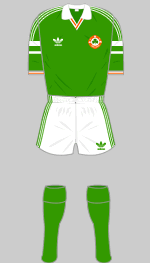
1988-1990
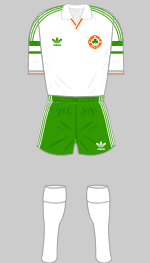
1988-1990 Change
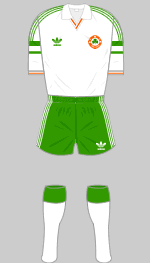
18 Oct 1989
v N Ireland
Designer: Adidas
 Charlton justified his appointment by guiding Ireland to the finals of the European Championships where they beat England, drew with the Soviet Union and were finally eliminated by the Netherlands, who went on to win the championship. The Adidas kit introduced ahead of the tournament was an updated version of Adidas' template (which proved as popular as their previous style with national sides). For the first time orange was incorporated as a third colour reflecting the colours of the Irish tricolour flag.
Charlton justified his appointment by guiding Ireland to the finals of the European Championships where they beat England, drew with the Soviet Union and were finally eliminated by the Netherlands, who went on to win the championship. The Adidas kit introduced ahead of the tournament was an updated version of Adidas' template (which proved as popular as their previous style with national sides). For the first time orange was incorporated as a third colour reflecting the colours of the Irish tricolour flag.
The shirts worn in Euro '88 had slightly smaller manufacturers' logos than those issued in other matches.
 1990
1990
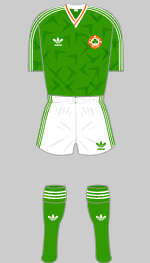
1990
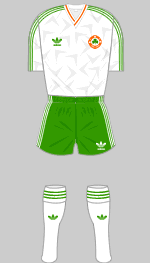
1990 Change
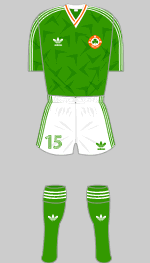
1990 World Cup Finals
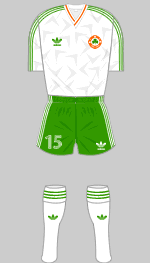
1990 WCF Change
Designer: Adidas
 Charlton steered Ireland to Italia '90 where once again they were paired with England, along with Egypt and the Netherlands. After drawing all three of their group matches, Ireland were awarded second place over Holland by the drawing of lots (the Dutch still qualified for the next stage as one of the four best third-placed teams). After a dramatic penalty shoot-out win against Romania, Ireland were finally beaten 0-1 by hosts Italy.
Charlton steered Ireland to Italia '90 where once again they were paired with England, along with Egypt and the Netherlands. After drawing all three of their group matches, Ireland were awarded second place over Holland by the drawing of lots (the Dutch still qualified for the next stage as one of the four best third-placed teams). After a dramatic penalty shoot-out win against Romania, Ireland were finally beaten 0-1 by hosts Italy.
As usual, a new set of kits was introduced at the beginning of the year, a return to the simple lines of the classic Adidas template but with the addition of an orange-trimmed wrap-over V neck and subtle chevrons woven into the shirt fabric. During Italia '90, players wore squad numbers on their shorts but otherwise their kits were identical to those worn before and after the tournament.
 1991-1992
1991-1992
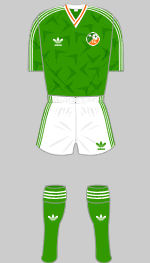
1991-1992
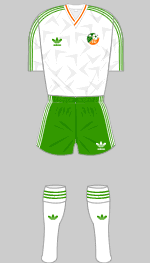
1991-1992 Change
Designer: Adidas
 The outfits in 1991 and 1992 were identical to those from the previous year aside from the new FA of Ireland crest.
The outfits in 1991 and 1992 were identical to those from the previous year aside from the new FA of Ireland crest.
 1992-1994
1992-1994
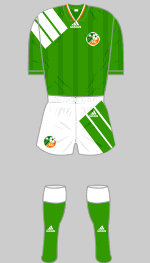
1992-1994
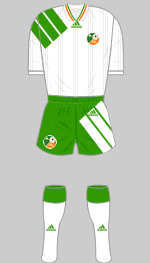
1992-1994 Change
Designer: Adidas
 In the early 1990s Adidas underwent a major re branding exercise replacing the famous trefoil trademark and three-stripe trim with a new "Adidas Equipment" logo and a bold contrasting motifs. This design, which was also adopted by Liverpool and Bayern Munich was criticised by many who thought the Adidas' branding overpowering.
In the early 1990s Adidas underwent a major re branding exercise replacing the famous trefoil trademark and three-stripe trim with a new "Adidas Equipment" logo and a bold contrasting motifs. This design, which was also adopted by Liverpool and Bayern Munich was criticised by many who thought the Adidas' branding overpowering.
These outfits were worn in Ireland's successful qualifying campaign for the USA '94 World Cup, which climaxed in a 1-1 draw with Northern Ireland in Belfast that clinched the Republic's place in the finals.
 1994
1994
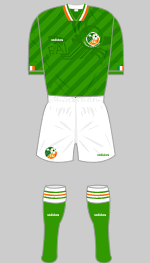
1994
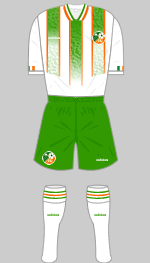
1994 Change
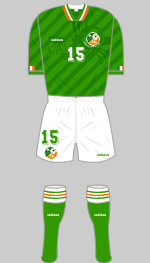
1994 World Cup Finals
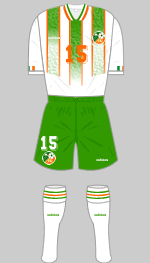
1994 WCF Change
Designer: Adidas
 With Ireland's place in USA '94 assured, Adidas introduced their new designs, which were worn in a series of preparatory fixtures in the spring of 1994. The aggressive branding was gone and the new green shirts featured diagonal shadow stripes and an intricate design, based on the FAI crest, woven into the front of the shirt. The change kit featured Adidas' three-stripe motif in a very unusual fading pattern edged with orange.
With Ireland's place in USA '94 assured, Adidas introduced their new designs, which were worn in a series of preparatory fixtures in the spring of 1994. The aggressive branding was gone and the new green shirts featured diagonal shadow stripes and an intricate design, based on the FAI crest, woven into the front of the shirt. The change kit featured Adidas' three-stripe motif in a very unusual fading pattern edged with orange.
For the finals squad numbers were added to the front of player's shirts and shorts. Ireland thrillingly beat Italy in their opening game, a result that eventually ensured their progression to the Second Phase after all four teams in the group finished on four points. Ireland were beaten 0-2 by the Netherlands in the next round but Jack Charlton had by this time ensured his status as an honorary Irishman.
<Republic of Ireland 1959-1978:
Home Internationals Index Page :
Republic of Ireland 1994-2010>

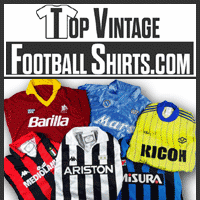

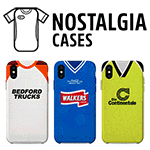













 1986-1987
1986-1987












 1991-1992
1991-1992



 In the early 1990s Adidas underwent a major re branding exercise replacing the famous trefoil trademark and three-stripe trim with a new "Adidas Equipment" logo and a bold contrasting motifs. This design, which was also adopted by Liverpool and Bayern Munich was criticised by many who thought the Adidas' branding overpowering.
In the early 1990s Adidas underwent a major re branding exercise replacing the famous trefoil trademark and three-stripe trim with a new "Adidas Equipment" logo and a bold contrasting motifs. This design, which was also adopted by Liverpool and Bayern Munich was criticised by many who thought the Adidas' branding overpowering. 


